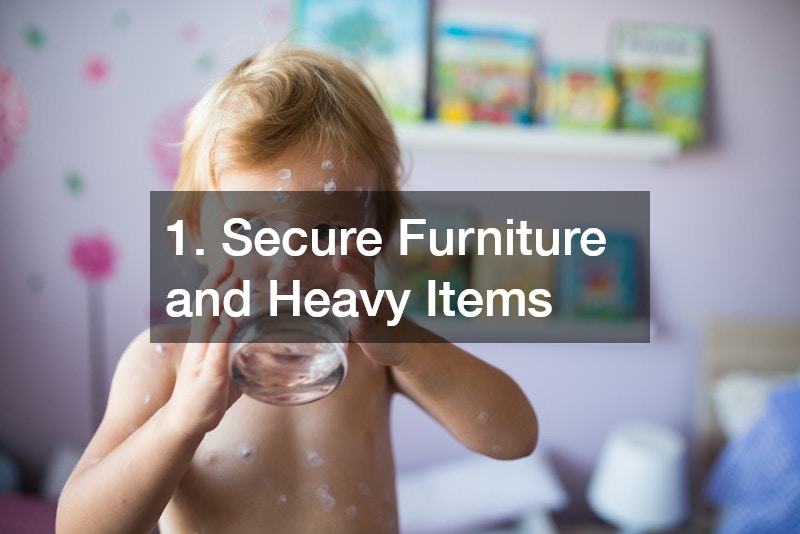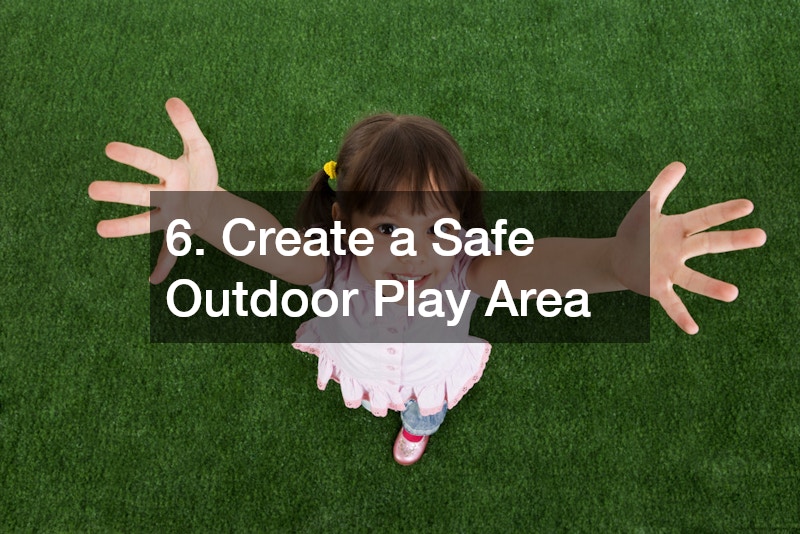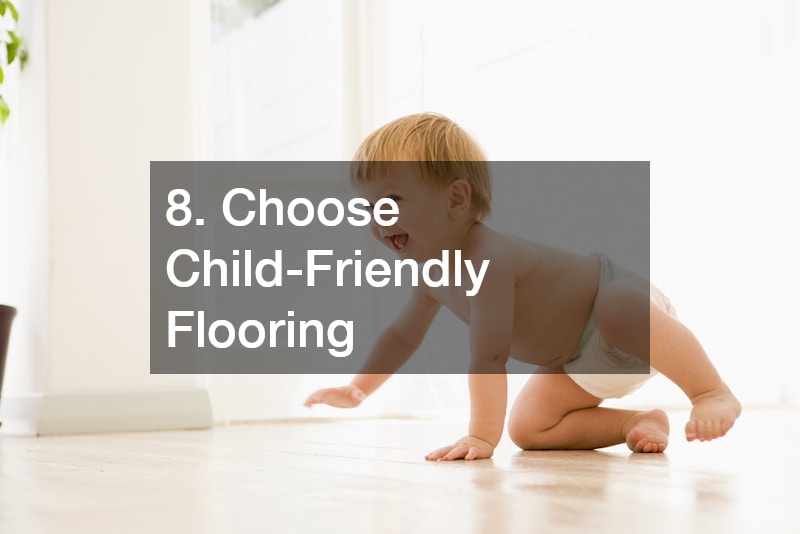As a parent, ensuring the safety of your child within the home is a top priority. Children are naturally curious and explore their surroundings without understanding the potential dangers around them. Even though it’s impossible to predict all possible home hazards, there are numerous steps you can take to make your home safer for little ones. From securing furniture to choosing the right flooring, these home improvements can provide peace of mind while your child grows and learns. In this article, we will outline eight essential home improvements every parent should consider making to keep their children safe.
1. Secure Furniture and Heavy Items

One of the most critical safety improvements you can make in your home is securing heavy furniture and items. Unstable furniture, such as bookshelves, dressers, and TVs, can tip over easily if climbed on or pulled. This poses a serious risk of injury or even death, especially in young children who are still developing motor skills and coordination.
Use Furniture Anchors:
Invest in sturdy furniture anchors or brackets that attach heavy items to the wall. This is especially important for items like bookshelves, dressers, and flat-screen TVs. The extra effort to secure these items can prevent tipping accidents. Many furniture manufacturers now include anchor kits with their products, or you can purchase adjustable wall straps designed specifically for this purpose.
Keep Heavy Items Low:
Store heavier items on lower shelves or cabinets where your child can’t reach. This reduces the temptation to pull or push heavy objects, minimizing the risk of them falling. Items like books, DVDs, or large toys should be kept on the bottom shelves, making them less likely to topple when touched.
Consider Custom Solutions:
If you have larger pieces of furniture, like custom-built bookshelves or media cabinets, a carpenter can help create more secure solutions by attaching them directly to the walls during installation. As a result, your furniture is not only stylish and functional but also anchored properly for added safety. A carpenter can also modify existing furniture, like adding brackets or reinforcing joints, to make it more secure for a child-friendly environment.
These precautions are essential to avoid accidents that often happen when children are exploring their environment. Not only will this prevent injury, but it will also give you greater peace of mind knowing that the items in your home are securely anchored, even in the event of an earthquake or rough play.
2. Install Safety Gates
Safety gates are a must-have for homes with young children. They provide a barrier between your child and areas of the house that could be dangerous, such as stairs, the kitchen, or rooms with fragile items. Installing safety gates in strategic places can prevent falls, restrict access to hazardous areas, and provide an extra layer of protection.
Stairway Safety:
Install gates at both the top and bottom of stairs. Stairways are one of the most common places where young children get injured, and safety gates can provide a barrier that keeps little ones from wandering into danger. This simple addition can dramatically reduce the risk of a fall, especially for toddlers who are just learning to walk or navigate steps.
Room-Specific Gates:
Consider additional gates for rooms where you keep cleaning supplies, sharp objects, or heavy appliances. These rooms often have items that pose a risk to children, so limiting access is key to avoiding accidents. For example, if you store sharp knives or chemicals in the kitchen, a well-placed gate can prevent a child from reaching these dangerous items.
Custom Gates:
In some homes, traditional safety gates may not fit the space or aesthetic you desire. If you have large or unique openings, you can hire welding services to create custom safety gates tailored to your home’s specific needs. A skilled welder can fabricate durable, child-safe gates that blend seamlessly with your décor while ensuring robust protection. Custom gates are especially useful for homes with irregular door frames or wider-than-average openings, where standard gates might not be effective.
Make sure that the gates you install are securely fastened to the wall, and check them regularly to ensure they remain in good condition. Avoid gates that can be easily opened by children as they grow older, opting for models with childproof latches. Regularly inspect the gates to make sure they’re still properly installed and functioning, especially if your child is becoming more mobile or curious.
3. Child-Proof the Kitchen

The kitchen is often called the heart of the home, but for parents of young children, it can also be one of the most dangerous rooms. With hot surfaces, sharp knives, and chemical cleaners, it’s essential to take extra precautions to child-proof the kitchen. Fortunately, several simple adjustments can greatly reduce the risks.
Cabinet and Drawer Locks:
Installing child-proof locks on kitchen cabinets and drawers is an effective way to keep dangerous items like knives, cleaning products, and plastic bags out of reach. Magnetic locks are a popular choice because they require an adult’s hand to open, making them especially challenging for curious little ones to tamper with.
Stovetop Knob Covers:
Curious toddlers often reach for stove knobs, which can lead to burns or accidental fires. Stovetop knob covers are a simple solution that blocks children from turning the knobs, particularly when the stove is in use or hot. These covers are easy to install and provide an added layer of safety.
In addition, keep sharp utensils and hot cookware out of reach, and clear the countertop of any dangerous items. Having a safe kitchen environment will reduce your worries while cooking and provide peace of mind when your little ones are nearby.
4. Update Electrical Outlets and Cords
Electrical outlets and cords are often overlooked as a safety hazard, but they pose a significant risk to young children. Babies and toddlers are particularly prone to sticking objects into outlets, and exposed cords can lead to tripping or strangulation.
Outlet Covers:
Installing outlet covers is a simple yet effective way to protect your child from electrical shock. Sliding outlet covers are an excellent option because they are difficult for children to remove and automatically close when the outlet is not in use. If you’re renovating your home, consider upgrading to tamper-resistant outlets, which feature built-in shutters to block foreign objects.
Cord Management:
Use cord organizers or covers to keep electrical cords neat and out of reach. Loose cords can tempt children to grab or play with them, leading to potential tripping hazards, electrical burns, or strangulation. For areas like cribs or play zones, opt for cordless or wireless devices whenever possible to eliminate risks altogether. If you have frayed or damaged cords, have an electrician repair or replace them to make sure they are safe and up to code.
Be vigilant about checking your electrical outlets and cords regularly so that they remain child-safe. These simple changes can make a big difference in preventing electrical accidents.
5. Softening Sharp Edges and Corners
Whether it’s a coffee table, bookshelf, or countertop, sharp edges and corners are a potential hazard for young children who are learning to walk, run, or climb. A fall onto a sharp surface can cause serious injuries, particularly to the head, which is why it’s essential to soften these home hazards.
Corner Guards:
Install corner guards or bumpers on furniture with sharp edges. These soft, cushioned covers absorb the impact if your child bumps into them, reducing the likelihood of cuts or bruises. They are widely available in neutral colors to blend with your décor while providing added safety.
Edge Padding for Tables:
Use edge padding on tables or countertops with sharp edges. These pads come in various designs and materials and can be easily installed or removed as needed. Edge padding provides a buffer against sharp surfaces, particularly in high-traffic areas where children play.
For a more comprehensive solution, consider opting for furniture that has rounder edges or purchasing child-friendly furniture that is specifically designed to minimize risks. Making these adjustments can prevent serious accidents and give you peace of mind as your child explores their environment.
6. Create a Safe Outdoor Play Area

Outdoor play is essential for a child’s physical and mental development, offering opportunities to run, climb, and explore. However, outdoor spaces can present safety challenges, so it’s crucial to create a secure play area free from hazards.
Fenced Play Area:
Installing a secure fence around your yard is one of the best ways to keep your child safe during outdoor play. A professional fence builder can help design and install a durable, child-proof fence that prevents children from wandering into the street or neighboring properties. The fence should be tall enough to deter climbing and that gates are self-closing and lockable to prevent accidents.
Soft Landscaping:
Opt for soft ground materials like grass, rubber mulch, or wood chips in play zones. These surfaces are much safer than concrete or gravel and can reduce the risk of injuries from falls. For added safety, ensure that areas under swing sets, jungle gyms, or other play equipment are cushioned with impact-absorbing materials designed for playgrounds.
Safe Pool:
If your yard includes a swimming pool, install a separate fence around it with a self-latching gate to make sure children cannot access it unsupervised. This is a critical step to prevent accidents and comply with safety regulations.
Additionally, check for any nearby home hazards such as sharp objects, poisonous plants, or small spaces where your child could get stuck. Keeping the area clean and well-maintained will ensure that your child can enjoy outdoor play safely.
7. Use Non-Toxic Paints and Materials
Children can be unknowingly exposed to harmful chemicals in their environment through paints, varnishes, and furniture. These substances, such as lead, formaldehyde, and phthalates, can negatively impact their health. Creating a safe home environment starts with choosing non-toxic paints and materials.
Low-VOC or Zero-VOC Paints:
Select paints with low or zero volatile organic compounds (VOCs). These harmful chemicals are released into the air as paint dries, potentially causing respiratory and developmental issues. Many interior house painters specialize in applying eco-friendly, non-toxic paints, ensuring your walls are safe and your home is healthier for your children. These modern options perform just as well as traditional paints, with the added benefit of improved air quality.
Natural Materials:
Incorporate natural and sustainable materials into your home. For example, opt for furniture and toys made from wood instead of plastic, which may contain harmful chemicals. You can also decorate with wooden wall accessories, adding both charm and a toxin-free touch to your child’s space. For fabrics and bedding, choose organic options that avoid harmful dyes and chemical treatments.
By prioritizing non-toxic options, you create a safer environment for your child to grow and thrive while also reducing your home’s overall chemical exposure. These thoughtful changes promote long-term health and peace of mind.
8. Choose Child-Friendly Flooring

When selecting flooring for a home with young children, it’s crucial to prioritize safety, durability, and practicality. Flooring plays a significant role in reducing the risk of injury while also withstanding the wear and tear that comes with an active household.
Soft Flooring Options:
Explore child-friendly flooring solutions like carpets or cork flooring. Carpets offer a cushioned surface that minimizes the impact of falls, while cork flooring provides a soft, non-slip surface that’s also eco-friendly. These materials are ideal for play areas and bedrooms where children spend most of their time. Visit a reputable carpet store to find a wide selection of options tailored to your needs.
Non-Slip Mats and Rugs:
For homes with hard flooring like tile or hardwood, non-slip mats and rugs are essential. They provide traction, reducing the risk of slipping accidents, especially in high-traffic areas or near play zones. Look for rugs that are easy to clean and feature a non-skid backing for added safety.
If you’re considering a more extensive update, consult professionals offering flooring services to help you select and install child-friendly options. Moreover, prioritize flooring materials that are easy to clean and stain-resistant, as spills and messes are inevitable with little ones.
The right flooring keeps your home safe and comfortable, giving your children a secure environment to explore and grow.
Final Thoughts
Child-proofing your home is one of the most important tasks for parents, and it doesn’t have to involve major renovations or expensive investments. By securing furniture, installing safety gates, child-proofing your kitchen, updating electrical outlets, softening sharp edges, creating a safe outdoor play area, using non-toxic paints, and choosing child-friendly flooring, you can create a safer environment for your child to explore. Implementing these home improvements will not only protect your little one from harm but also give you the peace of mind that comes with knowing you’ve taken the necessary steps to ensure their safety.

